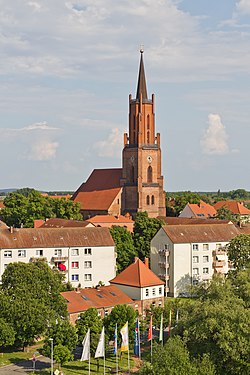Rathenow
Rathenow | |
|---|---|
 Church | |
Location of Rathenow within Havelland district  | |
| Coordinates: 52°36′N 12°20′E / 52.600°N 12.333°E | |
| Country | Germany |
| State | Brandenburg |
| District | Havelland |
| Subdivisions | 6 Ortsteile |
| Government | |
| • Mayor | Ronald Seeger (CDU) |
| Area | |
| • Total | 105.68 km2 (40.80 sq mi) |
| Elevation | 29 m (95 ft) |
| Population (2022-12-31)[1] | |
| • Total | 24,597 |
| • Density | 230/km2 (600/sq mi) |
| Time zone | UTC+01:00 (CET) |
| • Summer (DST) | UTC+02:00 (CEST) |
| Postal codes | 14702, 14712 |
| Dialling codes | 03385 |
| Vehicle registration | HVL (früher: RN) |
| Website | www.rathenow.de |
Rathenow (German: [ˈʁaːtənoː] ) is a town in the district of Havelland in Brandenburg, Germany, with a population of 26,433 (2007).
Overview
The Protestant church of St. Marien Andreas, originally a basilica, and transformed to the Gothic style in 1517-1589, and the Roman Catholic Church of St. George, are noteworthy.
Rathenow is known for its Rathenow stones, bricks made of the clay of the Havel, and for its spectacles and optical instruments, which are exported.
After the fall of the Soviet Union, it was revealed that the remains of Hitler and his assistants were secretly buried in graves near Rathenow.[2]
Demography
-
Development of Population since 1875 within the Current Boundaries (Blue Line: Population; Dotted Line: Comparison to Population Development of Brandenburg state)
-
Recent Population Development and Projections (Population Development before Census 2011 (blue line); Recent Population Development according to the Census in Germany in 2011 (blue bordered line); Projection by the Brandenburg state for 2005-2030 (yellow line); Projection by the Brandenburg state for 2014-2030 (red line); Projection by the Bertelsmann Foundation for 2012-2030 (green line)
|
|
|
Twin towns — sister cities
Rathenow is twinned with:
Notable residents

- Stephan Bodecker (1384-1459), Bishop of Brandenburg
- Jörg Friedrich (rower) (born 1959), rower
- Jörg Freimuth (born 1961), high jumper
- Mario Streit (born 1967), rower
- Jörg Heinrich (born 1969), football player and manager
- Christian Beeck (born 1971), footballer
- Joachim Mrugowsky (1905-1948), physician and Nazi war criminal; executed
- Immo Stabreit (born 1933), diplomat
- Rosemarie Köhn (born 1939), 1993-2006 Bishop of Hamar (Norway) (world's second woman as a Lutheran bishop)
- Wulf Herzogenrath (1944), art historian and curator
References
- ^ "Bevölkerungsentwicklung und Bevölkerungsstandim Land Brandenburg Dezember 2022" (PDF). Amt für Statistik Berlin-Brandenburg (in German). June 2023.
- ^ V.K. Vinogradov and others, Hitler's Death: Russia's Last Great Secret from the Files of the KGB, Chaucer Press 2005, 111. This work reproduces a Soviet map showing that the bodies were buried in a field near the village of Neu Friedrichsdorf, approximately one kilometre east of Rathenow.
- ^ Detailed data sources are to be found in the Wikimedia Commons.Population Projection Brandenburg at Wikimedia Commons
This article incorporates text from a publication now in the public domain: Chisholm, Hugh, ed. (1911). "Rathenow". Encyclopædia Britannica. Vol. 22 (11th ed.). Cambridge University Press. p. 916.
External links
![]() Media related to Rathenow at Wikimedia Commons
Media related to Rathenow at Wikimedia Commons
- . New International Encyclopedia. 1905.






